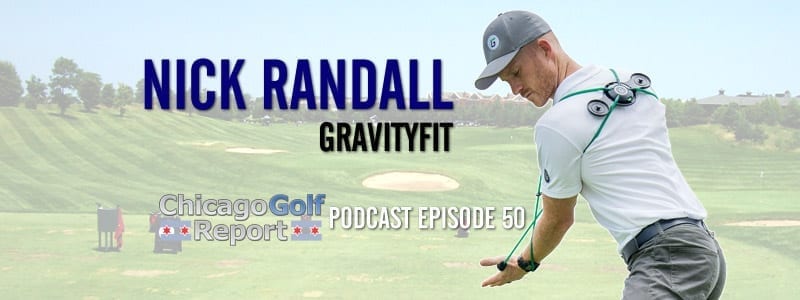

Our guest this episode is Nick Randall who is a strength and conditioning coach who works with PGA tour players. He is also a brand ambassador for GravityFit, which is a revolutionary exercise and rehabilitation system that has become popular with golfers and golf instructors.
In this interview with Nick, we learn:
- How your lifestyle could be impacting your ability to properly swing the golf club
- The primary reason why golfers become injured
- Why top PGA Tour professionals use the GravityFit TPro
- Why losing radius in the golf swing can cost more than just power
- How golfers in Chicago can improve their golf swing and rotation 12 months a year
- The secret to avoiding most musculoskeletal injuries
- A unique method to avoid chipping yips
Interviewer: Walter Lis. Running Time: 18:08
Click here to download an MP3 file.
The following transcript has been edited for length and clarity.
CHICAGO GOLF REPORT – Can you tell us about the genesis of GravityFit?
NICK RANDALL – The background of GravityFit is really interesting and I think it’s quite different to lots of other brands and products. We operate in a similar space of postural training and specifically golf movement patterns.
The background is essentially Gravity Fitness standard on the back of a 30-year academic career by Dr. Karen Richardson. Her research identified the need to load the body in a certain way in order to stimulate the deep muscle system to work properly.
If that deep muscle system isn’t working properly, posture tends to suffer. We get into a more and more hunched forward, head position, rounded up the back rounded shoulders position, pelvis and spine become unstable and our major joints become unstable. Exposing us to the risk of injury.
Her research pointed to the fact that we don’t get in our current lifestyles enough, what we call axial load or gravity sensory information. Basically, we don’t get the stimulus, that this deep muscle system needs in order to activate and hold us in good posture and hold their joints nice and stable.
At the end of her career she partnered with a couple of people in order to develop some exercise tools that would address that need and that’s where GravityFit the brand and the performance and exercise tools was born out of.
Now how that came to be involved with the golf side of things is that Dr. Richardson is Australian and she was presenting around Australia and one of the things that she presented at was a golf Australia training camp of which I was actually a part of. I was doing strength and conditioning for Golf Australia and there was a whole bunch of the best coaches and trainers and physios that are involved in golf at this conference, at this training camp.
Until we started using the early prototypes of these tools that Dr. Richardson had just completed the production of, we found amazing results with these really good elite players in a very, very short space of time. We were able to put the tools on these guys, give them some simple cues and their posture was improving really quickly, their movement patterns are improving really quickly and that had positive carry-over to the gym and all sorts of that golf move patterns in their golf swings.
That was about four or five years ago. And GravityFit slowly kind of mushroomed out from that first Golf Australia training camp to golf coaches, to golf physical therapists to golf fitness people, and then out into the wider consumer advice as well starting off for the league players.
But we’re getting more and more recreational golfers that are getting incredible results using the GravityFit equipment. I suppose that’s in a nutshell is the background of GravityFit where we’ve come from and then how we’ve gradually started to expand our reach out into the recreational golfer market.
CHICAGO GOLF REPORT – Can you talk a little bit about how GravityFit impacts a professional golfer? I know that you work with some elite players, including Cameron Smith on the PGA tour. How do they use Gravity Fit? Is it to improve that same response that the recreational player would be? Or do they take it up an entirely higher level?
NICK RANDALL – I think there’s a lot of similarities between the way an elite player would you use GravityFit and the way that a recreational golfer would use Gravity Fit. I’ll give you the example of Cameron, who I’ve worked with for a number of years.
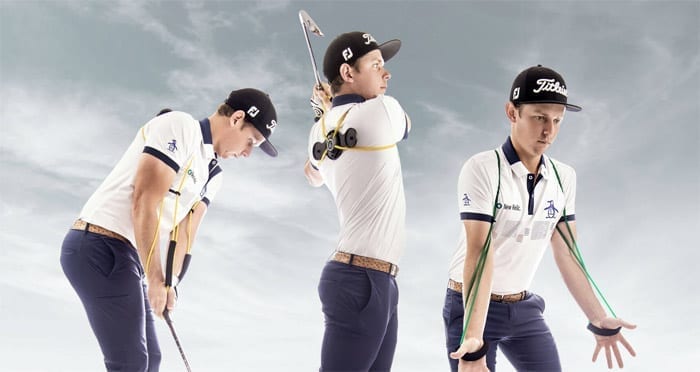
Cameron Smith – GravityFit
He’ll wear it on a day to day basis when he’s doing activities that aren’t even related to golf or even training for golf. He might even just wear it around the house.
The second way he’ll use it is he’ll start using the TPro and they’ll start using the band, the green bands to come with the TPro to activate the deep muscle systems. He’ll do some press type movements and incorporate into the gym.
He’s incorporated into the warmups for golf and he’ll do some press type movements and hinging and some rotating. That will help get that sensory information for the deep muscle system, make sure his postural tone is being held in a good position.
It will especially help his shoulder joints are being held in a really good position, with those big muscles. Then he’ll also look to work on some golf movement patterns.
If he’s working on a particular thing with his coach, he’ll use the TPro to help train that particular rotational movement pattern. Right now, he’s working on his takeaway especially, which is a thing that we always come back to with Cam.
Basically he wants a nice, connected take away. His arms tend to move away and outside the line in his backswing. He’s looking to try and just train a takeaway where his arms and body are a little bit more connected.
The last way he uses it is, he’ll switch out the green bands for the yellow bands, which are lighter resistance. The green bands is stronger, the yellow are lighter, and they’ll use the light to yellow bands to actually do some putting, chipping and pitching and try to translate the feel of the movement he’s making with the green bands into an actual club in hand, hitting shots scenario.
It’s not rocket science. It’s not particularly difficult to do. And I think any recreational golfer could benefit from using the TPro in the same way that Cameron Smith uses it.
CHICAGO GOLF REPORT – So let’s talk about that. You mentioned that there’s the TPRO and I know that there’s the green bands, there’s the yellow band. What’s the difference and how would someone using GravityFit use the green versus the yellow bands?
NICK RANDALL – The Green band is essentially a stronger resistance and the yellow are lighter resistance. That’s really the only difference.
The ways that it would get applied is the green bands would be used for the strength and stability part and the deep muscle activation part. You would be using it without club in hand. You wouldn’t even necessarily need to be in the golf context to get the benefit.
You would do press movements, rotation type movements to get that deep muscle system strong and firing and also work on those movement patterns that you want to be making when you’re in your golf swing.
The yellow band, as I’ve said, is slightly weaker, slightly less resistance and you would use those when you have club in hand or putter and handle wedge in hand and you wanted to transfer the fields, postural fields and movement pattern fields to actually hitting shots.
You can use those yellow bands to transfer those movement patterns fields. But you can also use it for more traditional ways of trying to, in the golf swing.
Maintaining radius is a big one. And that’s had a lot of tension in golf construction over the last little while.
A lot of players tend to lose radius, so their arms will bend at the elbow. If you’re a right-handed golfer, the lead arm will bend as you go into your backswing, you’ll lose weight and then it might bend even more as you go into your down swing.
When you lose radius, you lose control and you lose power. So that’s another way that you could use the yellow bands and when you’ve actually got club in hand and you’re hitting shots.
CHICAGO GOLF REPORT – When we think about a player like Cameron Smith, he’s a young guy, 25 years old, he looks in fantastic shape. I’m sure he’s as all flexible as the day as long, but for the majority of us who are older, we’re doing a lot of things in a daily basis that are kind of bringing those shoulders together and we’re getting a poor posture and I’m sure losing a tremendous amount of radius. What’s the approach that that a regular recreational golfer could use GravityFit, be it yellow or green? Here in Chicago, our actual golf season is limited. How could a golfer in Chicago use GravityFit 12 months a year?
You can use it for a number of things we’ve already discussed, but so much of an aging golfer or senior golfer or someone who’s even just struggling to maintain posture really, as we know, affects your ability to rotate. And as you said, maintain radius.
The TPro will help you get into better posture. And that’s the first key part.
If you’re in poor posture, then your movement patterns are going to be affected no matter how well you can move. If you do it from a poor start position, you’re going to struggle.
That improvement in posture, will give you extra range and radius automatically. You wouldn’t have to worry about contorting yourself into a pretzel to try and gain a little bit more thoracic or upper spine range of motion. Simply improving your posture and then having a better understanding of how to rotate efficiently will give you extra range and radius.
Now you can do that at home; you don’t need to be on the range, you don’t need to be in the gym. You can be watching the PGA Tour with the rain coming down outside and working on your rotation as you’re watching the TV.
It’s not particularly strenuous – it’s very, very simple. The implementation is very, very simple.
It’s perfect for someone who lives in a climate like you guys get often. You can do it anywhere and you don’t need to be at the range or be at the gym.
CHICAGO GOLF REPORT – In addition to improving our performance on the golf course, I know that another big aspect of improving our posture and improving our rotation capabilities is actual health and structural health. What are the health benefits of using the GravityFit on a consistent basis?
NICK RANDALL – If you combine the effects of poor posture and then unstable key joints, unstable spinal segments, unstable shoulders and an unstable neck, that’s a recipe for injury. That’s where most musculoskeletal injuries come from.
Then you inflict a huge amount of wear and tear on the joints. You might not notice it, but over time, that will start to develop into pain, chronic injury. And then you’re in the place where all of a sudden, you need surgery for an issue that could be fixed with normal physical therapy.
What we’d love to do is be able to help people to get into better posture and to stabilize the joints better, so they’re not being left exposed to joint wear and tear in injury. The joint and the spinal segments functioning as they’re designed to do in a nice stable position as opposed to being unstable and getting this kind of gradual wear and tear that will eventually lead to injury.
She’s ambitious, she wants people to be as healthy as we are designed to be and to stop breaking down and getting hurt all the time. That’s our real mission. To help people avoid injury surgeries and all the rest of the downfalls that come with pain and poor posture and unstable joints.
CHICAGO GOLF REPORT – Do you see the GravityFit as being something that Cameron Smith, with continued use, would hopefully allow him to stay healthy and extend his career?
NICK RANDALL – The number one priority for Cameron is injury prevention. That’s with all the physical approach, everything goes towards injury prevention first, career longevity. Then things that might be a little bit more exciting, like power and club head speed, come secondary to that.
I think that one of the reasons participation in golf is dropping is because people get hurt playing golf. And it’s tragic to have someone not be able to play golf in the way they want to either not play as often or have to take a cart when they don’t want to or just be out of the game due to injury. We’d love to help prevent that by getting people in a stronger and more stable position.
CHICAGO GOLF REPORT – What’s the benefit of using the TPro when you’re putting? Is it the same thing where you’re getting your spine and alignment properly?
NICK RANDALL – The TPro works really nicely for short game putting. I think as far as the golf application goes, it could be the best application for golf.
First of all, it gets you in good posture. When we get over a putter, or a wedge with a shorter length of the club, the ball is closer into us and we tend to hunch over even further.
It’ll give you awareness of posture first, but then it will promote more of a pendulum action where the arms are working together with the body. If you look at all the best short game players, you’ll see there’s very little going on with the arms, wrists when the putting. When they are chipping and when they’re pitching and it’s a predominantly body motion.
Most recreational golfers really struggle with this and that’s why they have issues with directional control, with putting and with, especially with contact. And the dreaded kind of chipping yips with their short game.
What we’re trying to do is get people in better posture first and then get their arms moving with that body. It’s more of a body hit as opposed to a slip or hands, wrist dominated movement through the ball.
Podcast: Play in new window | Download
Subscribe: RSS



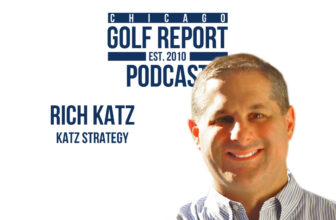
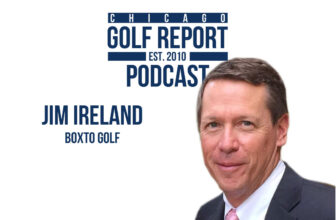
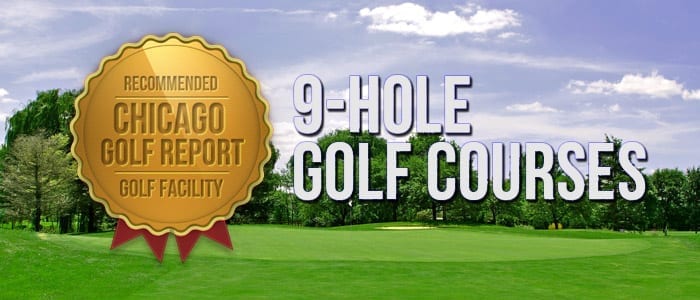
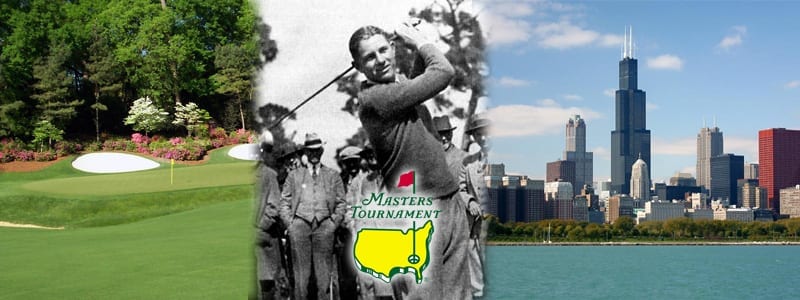

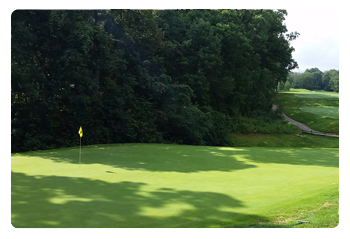 Find a Golf Course
Find a Golf Course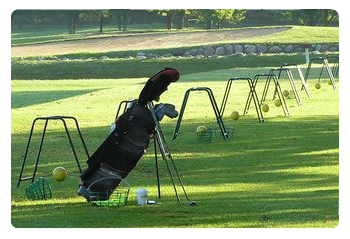 Find a Driving Range
Find a Driving Range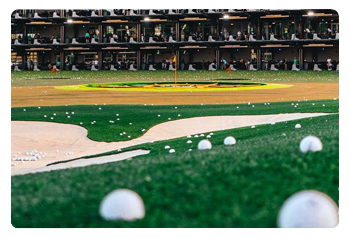 Find a Topgolf
Find a Topgolf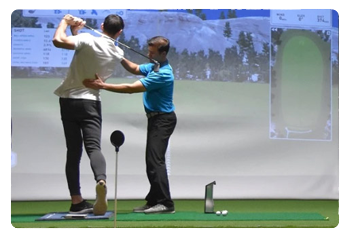 Find a Golf Instructor
Find a Golf Instructor